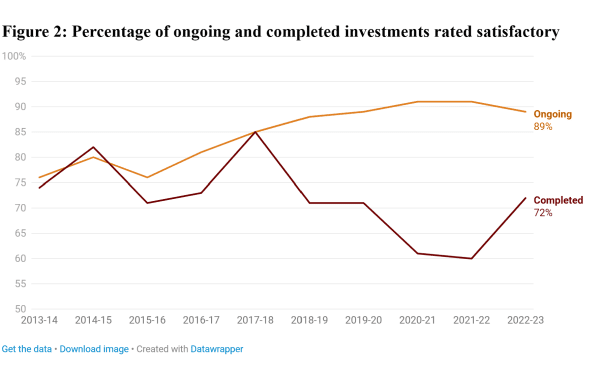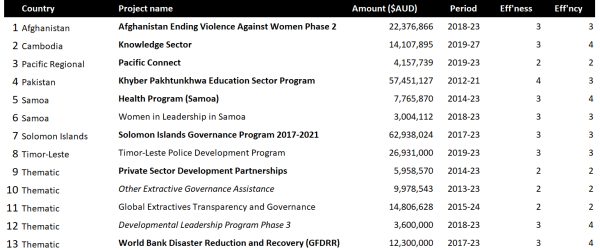Foreign aid was increased by 4% over what had been projected last year to bring the 2024-25 aid budget to $4.961 billion, virtually unchanged from the (inflation-adjusted) 2023-24 level of $4.900 billion.
The small increase this year is sustained into the future. In fact, after this year, aid is projected to stay almost exactly unchanged for the next decade and beyond. Over the forward estimates and beyond, the aid/GNI ratio is projected to continue to fall, from the current 0.19% to as low as 0.14% by 2035-36. It is very hard to see in these figures the aid “rebuild” that Labor claims to have embarked on.

Most country allocations are unchanged, but there are a few winners. The share of aid to the Pacific continues its inexorable rise, reaching 44% in this budget, up from 42% in 2023-24 and just 23% a decade earlier. Tuvalu’s aid allocation increases from $17 million in 2023-24 to $87 million in 2024-25 to support implementation of the Australia-Tuvalu treaty. ($87 million is also the amount of Australian aid budgeted for the whole of sub-Saharan Africa in 2023-24.) Fiji gets an additional $35 million for budget support and a port expansion. Indonesia gets an extra $27 million for a climate and energy initiative. There is also $65 million in new funding to support recent commitments to the Green Climate Fund and the Pacific Resilience Facility.
The biggest surprise is in sectoral allocations. Almost a quarter of the aid program went to health during the pandemic, and just below 20% in the last two years. But health spending is slashed in this budget to just 13% of total aid. That’s the second lowest it has been in the last decade, and not what you would expect from a Labor government, especially not one coming out of a pandemic. However, this government has made clear its commitment to governance and infrastructure, and the shares of both increase in this budget. Education and humanitarian spending are somehow protected, leaving health vulnerable, as it was under the Coalition prior to the pandemic.
While there is little else to report from the 2024-25 aid budget, there have been major changes over the last year in the way in which Australian aid effectiveness is conceived of and measured.
Australia’s new international development policy was released in August last year. It promised new country strategies, as well as new strategies on gender, disability and humanitarian aid. About nine months on, none of these has been published. But the first annual report on the “Performance of Australian Development Cooperation 2022-23” has been.
Up until 2020, the Australian aid program measured aid effectiveness by looking at the proportion of investments that were rated as satisfactory every year. Managers rated their own programs, and increasingly thought they were doing well. This indicator kept on improving, reaching 90% or more.
In 2020, a sensible decision was made: to judge aid effectiveness only by reference to the assessment of completed investments, assessments still made by DFAT, but at least not by the implementing manager. These assessments, being more independent, were more reliable, but they also gave much less impressive results, and ones that worsened over time.
In 2023, in the new policy, DFAT decided to hedge its bets and say that it would report both results. The problem with this approach is that it lays bare the large disconnect between ongoing and completed assessments that we highlighted in our report last year. For DFAT itself, this is not a bug but a feature: the completed investments are, it says, judged by a higher standard. The problem with this argument is that the disconnect only starts in 2019 – precisely when these completed investment ratings were taken out of the hands of project managers.
Although the disconnect appears to go down in 2022-23, in fact analysis shows that this is mainly due to the fact that the investments that came to an end last year were generally of above-average quality. The actual gap between the last rating an investment is given by its manager and the rating it is given by external consultants on closing has only fallen slightly.
The table below shows the problem at the individual investment level. These are the 13 investments rated in 2022-23 as unsatisfactory at completion. Only three of them were rated unsatisfactory when they had their last managerial or ongoing assessment. Two of them didn’t have such an assessment, and for eight of them, a verdict of satisfactory while ongoing was, on completion, downgraded to one of unsatisfactory.
Table 1: Unsatisfactory aid investments, 2022-23 evaluation period
Note: Bold indicates the investment went from satisfactory in its last ongoing rating to unsatisfactory in its final rating. Plain indicates no change in status from satisfactory to unsatisfactory or vice versa. Italics means no rating in the previous year. The effectiveness and efficiency scores are out of 5 (with 3 or less unsatisfactory). Source: DFAT performance data.
DFAT clearly needs to get an earlier handle on which investments aren’t working well, so that it faces fewer surprises when investments are closed, by which time it is too late to correct non-performance. Until the disconnect is reduced, performance should be judged with reference to completed, not ongoing, investments.
Locally-led development is a major priority for the new aid policy, so it is no surprise that the recently released performance report also has a section on it, with five indicators. Unfortunately, there is no mention of budget support, which is the most obvious and important way in which the Australian aid program supports locally-led development. Budget support is 2022-23 was 9.3% of the total aid budget, the highest it has been for at least a decade.
There is instead a strong focus on the hiring of national staff by managing contractors, who, we are told, hired 3,842 local staff and contractors in 2022-23, an increase of 15%. The benefits of hiring national staff are obvious. (As Lead Economist for the World Bank in India, I benefited from heading a terrific team of Indian economists.) But it’s not locally-led development. Indeed, in fragile states and small countries, hiring national staff can be a form of de-localisation, sucking talent out of local government, non-government organisations and private companies to work for donors at much higher salaries. As these two academics put it, donors can “subvert administrative capacity” when their “presence is large and skilled labour is extremely scarce.”
Data presented in the performance report imply that the average salary for a national staff member is $37,740, which is nine times the PNG minimum wage. Does the Australian aid program have a salary policy to ensure that, where it is a large donor, it is not distorting local labour markets, and thereby undermining localisation?
Other localisation indicators presented are more useful. Managing contractors pass on about 20% of the funding they receive to local organisations. Australian NGOs pass on very little of the development funding they receive, but 36% of their DFAT Australian Humanitarian Partnership funding. Adding these amounts together gives about $290 million, only two-thirds of the value of budget support in 2022-23.
A greater focus on funding local organisations – including governments – and a lesser one on hiring national staff is needed to push the localisation agenda forward.
Devpol’s Australian Aid Tracker has been updated with the new budget numbers.



